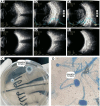Case report: Unveiling the silent threat in the ICU - a case of disseminated invasive aspergillosis in a patient with fulminant myocarditis
- PMID: 39650650
- PMCID: PMC11622249
- DOI: 10.3389/fimmu.2024.1481335
Case report: Unveiling the silent threat in the ICU - a case of disseminated invasive aspergillosis in a patient with fulminant myocarditis
Abstract
Invasive aspergillosis (IA) significantly increases mortality in critically ill patients in the ICU and its occurrence is closely related to immunocompromise. Dissemination of IA is easily misdiagnosed and mistreated due to its ability to invade multiple systems throughout the body and lack of typical clinical manifestations. In this case, a 25-year-old previously healthy woman was hospitalized with fulminant myocarditis and treated with veno-arterial extracorporeal membrane pulmonary oxygenation (VA-ECMO) support and intravenous acyclovir, high-dose methylprednisolone, and immunoglobulin. 6 days later, she was successfully weaned from VA-ECMO and underwent cardiac rehabilitation. On day 10, she developed a fever (Tmax 38.3°C) and an irritating cough and began to experience reduced vision over the right eye with eye pain, redness, photophobia, and tearing 2 days later. Administration of levofloxacin eye drops and tobramycin/dexamethasone eye ointment was ineffective. The patient was positive for serum Aspergillus galactomannan antigen. Positron emission tomography/computed tomography (PET/CT) scan showed multiple hypermetabolic cavitary nodules in both lungs (SUVmax3.6) and thickening of the ocular ring wall with hypermetabolism in the right eye (SUVmax3.2). Ophthalmologic examination revealed that her best-corrected visual acuity in the right eye was reduced to light perception with an intraocular pressure of 21 mmHg, and B-scan ultrasonography showed vitreous opacity and retinal edema with mild detachment in the right eye. Metagenomic next-generation sequencing (mNGS) identified a large number of Aspergillus fumigatus sequences in bronchoalveolar lavage fluid, blood, and aqueous humor from the right eye, supporting the diagnosis of pulmonary and ocular involvement due to disseminated IA. Vitrectomy, anterior chamber irrigation, combined with intravenous and intravitreal injections of voriconazole and liposomal amphotericin B eventually cured the patient. This case highlights the importance of early identification and intervention regarding disseminated IA in immunocompromised critically ill patients, especially in the presence of multiple organ involvement.
Keywords: PET/CT; disseminated infection; immunocompromise; invasive aspergillosis; mNGS.
Copyright © 2024 Xue, Mo, Cheng, Xue, Chen, Lin and Chen.
Conflict of interest statement
The authors declare that the research was conducted in the absence of any commercial or financial relationships that could be construed as a potential conflict of interest.
Figures




Similar articles
-
Aspergillus pseudodeflectus: a new human pathogen in liver transplant patients.BMC Infect Dis. 2018 Dec 12;18(1):648. doi: 10.1186/s12879-018-3527-5. BMC Infect Dis. 2018. PMID: 30541477 Free PMC article.
-
Aspergillus endophthalmitis: Potential role for vitreous galactomannan testing?Int J Infect Dis. 2020 Jul;96:151-153. doi: 10.1016/j.ijid.2020.04.037. Epub 2020 Apr 24. Int J Infect Dis. 2020. PMID: 32339725
-
Invasive Pulmonary Aspergillosis.Semin Respir Crit Care Med. 2020 Feb;41(1):80-98. doi: 10.1055/s-0039-3401990. Epub 2020 Jan 30. Semin Respir Crit Care Med. 2020. PMID: 32000286 Review.
-
Successful treatment of invasive tracheobronchial pulmonary aspergillosis with venovenous extracorporeal membrane oxygenation and combined systemic, intratracheal instillation of liposomal amphotericin B: a case report.J Med Case Rep. 2022 Dec 20;16(1):470. doi: 10.1186/s13256-022-03692-1. J Med Case Rep. 2022. PMID: 36536458 Free PMC article.
-
Invasive aspergillosis in developing countries.Med Mycol. 2011 Apr;49 Suppl 1:S35-47. doi: 10.3109/13693786.2010.505206. Epub 2010 Aug 18. Med Mycol. 2011. PMID: 20718613 Review.
References
-
- Bassetti M, Giacobbe DR, Grecchi C, Rebuffi C, Zuccaro V, Scudeller L, et al. . Performance of existing definitions and tests for the diagnosis of invasive aspergillosis in critically ill, adult patients: A systematic review with qualitative evidence synthesis. J Infect. (2020) 81:131–46. doi: 10.1016/j.jinf.2020.03.065 - DOI - PubMed
Publication types
MeSH terms
Substances
LinkOut - more resources
Full Text Sources

